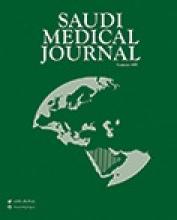Abstract
OBJECTIVE: To assess lipid profile and lipid peroxidation in type 2 diabetics with proliferative retinopathy (PDR), and investigate the association between these biochemical parameters and PDR.
METHODS: This study was conducted between June 2011 and February 2012 in the Research Laboratory, College of Applied Medical Sciences, Qassim University, Qasssim, Kingdom of Saudi Arabia. The study included 54 patients with type 2 diabetes (21 with PDR and 33 controls) and 30 healthy subjects. The biochemical parameters were measured using standard laboratory procedures.
RESULTS: Patients with PDR characterized by significantly (p<0.05) increased levels of serum cholesterol, triglyceride, low density lipoprotein (LDL-C), plasma malondialdehyde; decreased levels of serum high density lipoprotein (HDL-C) and apolipoprotein A1 (Apo A1); positive correlation of malondialdehyde with triglyceride, but negative with HDL-C, Apo A1. In logistic regression, malondialdehyde, LDL-C, and Apo A1 were not associated with PDR. However, triglyceride (OR = 1.745; p=0.000), total cholesterol (OR = 0.079; p=0.000), and HDL-C (OR = 10.676; p=0.000) were independent risk factors for developing PDR.
CONCLUSION: Dyslipidemia and lipid peroxidation may play a role in pathogenesis of diabetic retinopathy. Patients with PDR displayed marked lipid abnormalities and increased lipid peroxidation. The control of lipid alterations through glycemic control and/or lipid lowering medication is required for type 2 diabetics at least to postpone or prevent loss of vision from retinopathy.
- Copyright: © Saudi Medical Journal
This is an open-access article distributed under the terms of the Creative Commons Attribution-Noncommercial License (CC BY-NC), which permits unrestricted use, distribution, and reproduction in any medium, provided the original work is properly cited.






